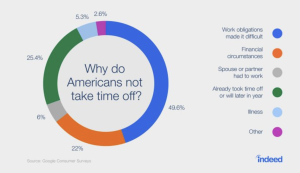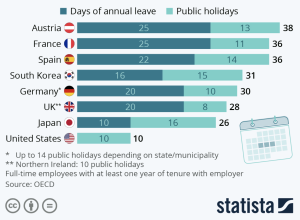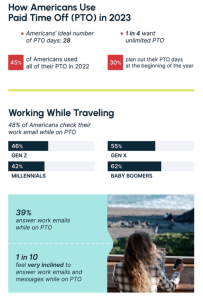It’s September. Back to the flow, back to the office, bye-by holidays for another year. Yes?
But does it really have to be this way?
It seems to me – as autumn approaches – that even in these times of supposedly valuing people’s wellness, and too many leaders and managers still overvalue overwork.
They reward the employees who stay late,and continue answering emails long after everyone else has departed the office.
Qudos is given to those who forgo vacation time to get even more done.
Leaders appear to view these behaviors as signs of diligence and loyalty to the company. Not only this, they encourage other employees to follow the lead of these exceptional colleagues – those who really “go the extra mile” or “live at the office.”
But what they don’t often realize is that these employees are often at risk of burnout, which can lead to poor performance, high levels of stress, and turnover.
Too many pressures
It may well be 2023, but too many workplace cultures make increasingly strenuous demands on employees’ time and personal lives.
Instead of prioritizing employee wellbeing, these cultures embrace productivity at all costs.
Ironically, it it doesn’t take long before companies realize that these costs are too high.
When employees don’t have time and space to recuperate, they are disengaged at work, more likely to make mistakes, and ultimately they become less productive.
Some overworked employees will decide to move on, which will force companies to absorb the cost of finding and training a replacement.
According to a recent survey of more than 10,000 employees in six countries (including the US and Britain), 42% of workers said they are burned out at work. The same survey reports that burned out employees are 3.4 times more likely to search for a new job in the coming year.
Beyond the prospect of losing employees (with all the costs and disruption caused by turnover), burnout contributes to the widespread engagement crisis.
Gallup reports that just 23% of employees feel engaged at work, while workplace stress has reached record levels. Some 44% of employees say they feel stress during “a lot of the day.”
Given all this, it’s no surprise that more than half of employees admit to “watching for or actively seeking a new job.”
These figures should be deeply alarming to HR teams, as they demonstrate that burnout isn’t just ubiquitous but that it has a clear negative impact on employee well-being, performance, and workplace culture.
Preventing burnout
Burnout is one of the most pervasive and destructive problems in modern workforces, but it can be prevented.
Companies need to develop workplace cultures that take employee well-being seriously. This means supporting employees’ mental health, promoting a sustainable work-life balance, and most importantly, having a Paid Time Off (PTO) culture that encourages employees to completely disconnect from work.
Employees just aren’t taking holiday – it needs sorting
When it comes to a company’s culture, burnout is part of a vicious cycle.
While burnout contributes to an unhealthy culture by harming productivity and increasing tension in the workplace, it’s also the product of cultural problems.
Among the most serious of these problems is a culture of overworking, leading to the unwillingness (and in many cases, inability) to take sufficient and uninterrupted PTO.
For example, almost half of American employees say they work at least an hour per day – even while on vacation(!), and even when they are technically ‘off’’ many say their employers still expects them to answer phone calls and texts (31%), respond to emails (27%), and remain online (20%).
Then there’s the employees who don’t take any PTO at all – the average employee had almost ten unused vacation days at the end of 2021.
A recent 2023 Pew survey found 46% of American workers don’t take all their available PTO.
What’s causing a lack of holiday taking? Culture

At the most fundamental level, burnout is a cultural problem.
Even when employees have earned PTO, they don’t feel free to take it due to perceived social and cultural constraints.
Pew reports 49% of employees worry that they’ll fall behind at work if they take time off.
Meanwhile 43% are concerned their absence will impose additional work on their colleagues.
Almost one-fifth of employees believe a vacation could hurt their chances of advancement and 16% even think there’s a risk they’ll lose their jobs.
Holiday anxiety needs breaking


Despite all this anxiety about taking time off, 89% of employees say PTO is very or extremely important – which is higher than the number of employees who say the same about employer-sponsored health insurance and retirement programs.
The disconnect between the demand for PTO and how employees are actually using (or failing to use) it should concern HR professionals.
To address this disconnect, HR teams need to encourage employees to use the PTO they’ve earned, create a culture in which they won’t be punished for fully disconnecting from work, and provide flexibility in how vacation time is accrued and used.
Many companies believe the implementation of an “unlimited” PTO policy will solve these problems, but a PTO Exchange survey found that three-quarters of employees who have such a policy say they’re still expected to work while on vacation. Again, it all comes down to culture.
Takeaways
With September now upon us, a mental shift takes place – that summer is over, time off is over, and it’s back to work as normal.
But holiday should be an all-year event, and employees shouldn’t be embarrassed to take it.
All HRDs worth their salt will know that employee burnout is a stubborn problem.
When employees feel burned out, the quality of their work suffers, their relationships with colleagues deteriorate, and feel less mentally and physically healthy.
But they should also know that it’s a solvable problem.
When HR teams give employees the time and space they need to take a real break from work, they’ll drastically increase the well-being of their workforces, resulting in higher retention and productivity.
Employees have the answer. It’s they who recognize that work-life balance is critical for their mental health and productivity.
Many are now willing to abandon companies that don’t share this perception.
This is why HR teams need to take burnout seriously by providing the resources, flexibility, and benefits – particularly PTO – that will help employees focus on their well-being.
What the stats say:
A recent McKinsey survey of 15,000 employees and 1,000 HR decision-makers found:
- There was a 22% gap between employee and employer perceptions of mental health and wellbeing in the workplace.
- A shocking 58% of US workers say their job is their main source of mental health challenges.

